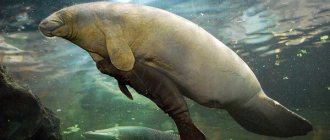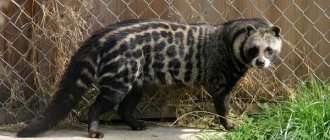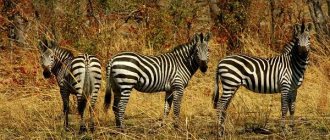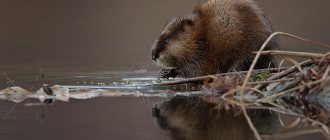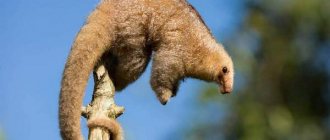Manatees are members of a genus of large aquatic mammals that are grouped into the family Trichechidae (manatees), the sirenian order. In nature, there are 3 species of manatees and one possible: Amazonian, American, African and dwarf. Another name for manatee is sea cow.
| Latin name | Trichechus |
| Kingdom | Animals |
| Type | Chordata |
| Class | Mammals |
| Squad | Sirens |
| Family | Manatees |
| Infraclass | Placental |
| Genus | Manatees |
| Body length | American manatee - 3.5 m; Amazonian manatee - 2.5 m; African manatee - 3.5 m; dwarf manatee - 1.3 m. |
| Weight | American manatee - 450 kg; Amazonian manatee - 420 kg; African manatee - 450 kg; dwarf manatee - 60 kg. |
Description
— Advertising —
The manatee is a representative of large marine mammals. The three species of this family have a body length of about two and a half to three and a half meters, and only dwarf manatees grow to a maximum of one and a half meters.
Manatees are characterized by a fusiform (the term is derived from the word spindle) massive shape, which is completely covered with a thick layer of skin. Characterized by gray color and lack of hair. The only exception is the vibrissae - coarse hair on the face. You can look at the manatee photo of the animal attached below.
Vibrissae are tactile hairs and transmit air vibrations of the surrounding space to the brain. This not only helps the animal search for suitable directions and food, but also avoid dangerous collisions. In fact, vibrissae are mammalian receptors that have changed over the course of evolution.
It is noted that manatees have 6 cervical vertebrae, while other mammals have 7. The animal has a small head, which it cannot turn from side to side. This may be due to a missing vertebra. Manatees have to spin on an axis to see the terrain.
— Advertising —
The muzzle is small and square in shape. On the sides of the front part there are small, deep-set eyes, the eyelids of which close in a circular manner. There is a special membrane on the eyes that protects the pupils and iris. The manatee lacks an external ear structure, but this does not prevent the animal from hearing perfectly.
On the muzzle there are large, deeply divided lips, whose role is to collect food. Food is collected simultaneously in both lips. A characteristic feature of manatees is the constant replacement of molars. The process goes like this: old teeth grow back, gradually pushing them out to the front of the jaw.
In the front part of the body there are flattened limbs that form fins. These flippers have nail-like hooves. The body is completed by a flattened caudal fin, shaped like an oar. These fins are just one blade.
Lifestyle
Manatees prefer either complete solitude or movement in pairs. These animals are not territorial, so leadership and following the leader is alien to them. They are active in the evening, night and morning, but rest during the day. It is noted that manatees living in captivity feed during the day.
Manatees gather in flocks preferably only in two cases: 1. when the mating period begins; 2. There is a sun-warmed area with abundant food. As a rule, such gatherings do not exceed more than 6 individuals in a flock.
Manatees are unable to live in water temperatures below 17 degrees Celsius. Cold water absorbs too much heat, and due to the animals' slow metabolism, the situation makes it harder for manatees to stay warm. Therefore, sea cows constantly migrate in search of warm waters. They prefer temperatures around 22 degrees Celsius.
Manatee aggregations are most often observed in artificial warm waters that form as a result of power plant outflows. Which may seem counterintuitive, but it is power plants that help manatees not become extinct. Also, the manatee lives in warm natural springs, canals and pools.
Manatees do not come onto land and are considered fully aquatic animals. In order to fill the body with oxygen, animals stick their nostrils to the surface and dive back for 1-2 minutes. Although, the size of light manatees allows them to stay under water for about 20 minutes.
These animals prefer to live in shallow water. Here they breed, feed and sleep, only occasionally leaving the waters to take a breath of fresh air. They move along the bottom using their front flippers.
Animal Features
- These many-kilogram creatures prefer to lead a “sedentary” lifestyle; they do not like to move long distances and swim no more than 3-4 kilometers a day. Most of the day is spent in shallow water, where everyone does something to their liking: some “nibble” grass, others relax, slowly swaying at the surface of the water or sitting comfortably on the bottom.
- They breathe infrequently. They come to the surface for a new breath of air no more than after 10-15 minutes, and even less often during sleep.
- These animals are vegetarians to the tips of their flippers. They put almost any aquatic vegetation into their mouths. In this matter, they sometimes help themselves with flippers.
Nutrition
Manatees are vegetarians and feed exclusively on aquatic plants. For example, the sea manatee eats sea grasses, and the one that lives in rivers eats freshwater. It is also noted that manatees are able to consume algae.
Due to the low calorie content of their food, manatees feed very frequently. According to National Geographic researchers, an adult consumes one-tenth of its body weight per day - that's 50-60 kg of plants.
Where do manatees live?
Manatees live on the Atlantic coast. The distribution area starts from the states of Georgia and Florida (Southeast USA) and continues all the way to Brazil. Manatees completely inhabit the Gulf of Mexico and the Caribbean Sea.
Also, manatees live in rivers such as the Amazon and Orinoco, so they can be found inland. On the Western Atlantic side, manatees are common along the coast of the African continent, which stretches from Senegal to Angola.
Kinds
Today there are 3 official species of manatees and one possible species.
Amazonian manatee
This representative of manatees lives exclusively in fresh water. Habitat: Amazon River and its tributaries. The preferred habitat is standing water bodies, lagoons, and river backwaters. The area must be saturated with vegetation for food. Characteristic differences: there is a white or pinkish spot on the chest, and there are no rudiments of claws on the flippers.
American manatee
Adapted to both salt water and fresh water. Lives in shallow ocean waters, but preferably chooses fresh water bodies for its habitat. The fins have peculiar hooves. They can be distinguished from other representatives by their bluish-gray body color, as well as by their forked upper lip, which allows them to quickly grab food.
African manatee
They choose small reservoirs filled with fresh water for their habitat. They can also live in coastal waters, the depth of which is not more than three meters. Characteristic differences are the gray-black coloring of the body and on the flippers there are formations similar to claws.
Pygmy manatee
This possible manatee species lives in shallow areas of the river with fast currents. The distribution area is small: a tributary of the Aripuanan River, which is located in the Amazon basin.
The body length of an adult is just over a meter, and its weight is 60 kg. The pygmy manatee is the smallest member of the entire family. The body color is black, there is a white spot on the belly.
Currently, the International Union for Conservation of Nature has not officially recognized pygmy manatees.
Notes
- Sokolov V.E.
Five-language dictionary of animal names. Mammals. Latin-Russian-English-German-French. - M.: Russian language, 1984. - P. 10. - 352 p. — 10,000 copies. - ↑ 12345
Husar, Sandra L. Trichechus inunguis. Mammalian Species, No. 72, pp. 1-4. Published June 15, 1977 by The American Society of Mammalogists. - Robert M. Timm, Luis Albuja V., Barbara L. Clauson. Ecology, Distribution, Harvest, and Conservation of the Amazonian Manatee Trichechus inunguis in Ecuador. Biotropica, Vol. 18, No. 2 (Jun., 1986), pp. 150—156
- Mondolfi, E. Taxonomy, distribution and status of the manatee in Venezuela. Mem. Soc. Cienc. Nat. La Salle, 34(97):5-23; 1974
- ↑ 12
Nowak, R. M. 1999. Walker's Mammals of the World. 6th Ed. The Johns Hopkins Univ. Press, Baltimore. - Eisenberg & Redford. Mammals of the Neotropics, Vol. 3 - The Central Neotropics (Ecuador, Peru, Bolivia, Brazil). Univ. of Chicago Press, Chicago, IL, USA. 1999.
- Robin C. Best. Apparent Dry-Season Fasting in Amazonian Manatees (Mammalia: Sirenia). Biotropica, Vol. 15, No. 1 (Mar., 1983), pp. 61-64.
- Allen, GM Extinct and Vanishing Mammals of the Western Hemisphere (with the Marine Species of All the Oceans). American Committee for International Wildlife Protection. 1942.
- Sirenia Specialist Group (1996). 2006. IUCN Red List of Threatened Species. World Conservation Union IUCN. The view is recorded as Vulnerable (VU A1cd v2.3)
- . Official website of the CITES Convention.
Reproduction
During the mating season, more than a hundred males hunt for a female manatee. Popularly, a female is called a cow, a male is called a bull, and a group of hunting males is called a mating herd.
To distinguish females from males, researchers look at the manatee's lower body. In the male, the genital opening is located just below the navel, and in the female, just above the anus.
Manatees do not try to impress the female and are not romantic animals. During the breeding season, the herd pursues the female and mating occurs indiscriminately. We can say that older males have success in fertilization. Once a male manatee impregnates a female, he no longer takes any part in the female's life.
It is noted that the reproductive frequency of these animals is very low. For example, the age of maturity for both sexes is about five years. Speaking on average, one cub is born approximately every two or five years.
Although childbirth can occur at any time of the year, it is noted that most often it occurs in the warm spring and summer. The pregnancy lasts 12 months, and the birth takes place under water. Immediately after birth, the mother helps the manatee (or calf, as they say) rise to the surface and take a breath of fresh air. After this, at the end of the first hour of life, the cub can swim independently.
The mother feeds the manatee calf through the nipples, which are located behind the flippers. The feeding period lasts one to two years and during this time the baby is completely dependent on the mother.
Lifestyle and habitat
Apart from the close bond between mothers and their young (calves), manatees are solitary animals. Sissy bumpkins spend approximately 50% of their lives sleeping underwater, regularly “coming out” for air at intervals of 15-20 minutes. The rest of the time they “graze” in shallow water. Manatees love peace and swim at speeds of 5 to 8 kilometers per hour.
No wonder they were nicknamed “ cows ”! Manatees use their flippers to propel themselves along the bottom while they busily dig up plants and roots from the substrate. The rows of horns in the upper part of the mouth and lower jaw tear food into pieces.
These marine mammals are strikingly non-aggressive and anatomically incapable of using their “fangs” to attack. You'll have to put your whole hand into the manatee's mouth to get to a few of the teeth.
Animals understand some tasks and show signs of complex associative learning, and they have good long-term memory. Manatees make a wide range of sounds used in communication, especially between mother and calf. Adults “talk” less often to maintain contact during sexual play.
Despite their massive weight, they do not have a continuous layer of fat like whales, so when the water temperature drops below 15 degrees, they tend to warmer areas. This played a cruel joke on the gentle giants.
Many of them have adapted to bask near municipal and private power plants, especially in winter. Scientists are concerned: some of the morally and physically outdated stations are closing, and heavy nomads are accustomed to returning to the same place.
Enemies of manatees
In their natural habitat, threats to baby manatees include crocodiles, alligators and sharks. Also, manatees cannot tolerate cold, so they can die due to cold stress. For example, in 2010, 246 manatees died due to abnormal cold in Florida. Other threats include pneumonia, gastrointestinal illness and red tide.
The real problem for manatees is people. Firstly, these are slow animals that are not able to quickly swim away from hunters. Secondly, being in shallow water, they can easily hit the bottom of the boat and suffer injuries that lead to death.
Species status
Are manatees extinct or not? This question often interests Internet users. Not yet, but manatees are endangered. The IUCN lists the animals as Vulnerable or at High Risk of Extinction. The organization estimates that the manatee population will decline by 30% over the next 20 years.
Hunting manatees is prohibited by law. For example, sea cows living in the state of Florida were included in the Red Book list back in 1967. At that time there were only about two and a half thousand individuals. Thanks to more than 40 years of hard work, the manatee population in the area has increased by 20%.
There are at least 10 thousand individual manatees in Africa. But it is impossible to track the number of individuals in the Amazon, so there are no official data.
However, the reason for this is not only mortality, but also the fact that manatees rarely leave offspring.
Dangers
Manatees have few natural enemies, but those that exist are very dangerous. In rivers, sirens are attacked by crocodiles, in the seas - by sharks. But animals, despite their apparent clumsiness, can stand up for themselves. Possessing remarkable strength, manatees offer serious resistance to their enemies and often win. Young animals who have no experience fighting predators suffer the most.
Sirens' vision is poorly developed, but good sense of smell and hearing compensate for this deficiency. But they perceive high-frequency sounds best. It is in this sound range that animals communicate with each other. Some sounds cannot even be heard by the human ear, and what people hear sounds like quiet, mournful moans. This is where the French name for these animals comes from.
History of extinction
Previously, the meat, fat and skin of manatees were highly valued, which led to intensive fishing for these animals and, as a result, a sharp decline in their numbers. At the moment, hunting them is strictly prohibited and in many countries this animal is protected by law. As is the case with many other species, the tragedy began with the appearance of a white man in the territory where the manatees lived. Before him, only local residents hunted manatees. The first Europeans, having discovered a large, easily accessible animal with tasty meat, excellent skin and healing fat, did not fail to take advantage of this and began to actively hunt it. There was a demand for hides and fat, which were used to make medicinal ointments and cosmetics. New settlers, populating the vast expanses of new countries, also enjoyed eating meat that tasted like pork.
But the number of manatees soon began to decline everywhere. Due to low fertility, populations could no longer cope with self-reproduction, and animals began to disappear from the most accessible areas of their range. The Florida subspecies was saved only by the fact that the local government passed a law in 1892 to protect manatees on its territory. However, in the second half of the 20th century, only two and a half thousand Florida manatees remained, and their numbers continue to slowly but steadily decline. There is practically no data on other species, but the situation there is no better.
Causes
Currently, new limiting factors have emerged that affect the numbers of these species. First of all, this is, of course, the settlement of coastal areas of seas and rivers by humans. Rivers and underwater pastures began to become polluted with a variety of debris, which led to a decrease in their feeding potential. For the manatee, which spends most of its time in coastal waters, this moment had a huge impact. Trusting creatures, they still fearlessly swim up to humans, often suffering from their carelessness. Previously, they turned out to be targets for hunters and for young people having fun. They threw knives at them, shot for fun with bows and crossbows, and threw stones. Even today there are barbarians who take pleasure in torturing defenseless animals. Fishing nets cause many problems for manatees. Once caught in an insidious snare, sirens can suffocate without ever freeing themselves from their bonds.
But the greatest danger for sirens is navigation in their habitats. The fact is that manatees do not pick up the low sounds made by the engine and do not veer out of the way of a yacht or motor boat. Swimming near the surface of the water, they are also practically invisible to people operating ships. The result is a collision, often leading to the death or injury of the animal. Many animals have terrible scars on their backs from wounds inflicted by propeller blades. In narrow shipping channels they are generally simply crushed.
If we add to all of the above the low reproductive capacity and short lifespan of manatees (only about fifty years), then the reasons for the decline in the species’ numbers become clear. After all, a female, as a rule, gives birth to one cub every two or three years, and many more animals die.
Nevertheless, hope remains for the revival of this family. Already today, the authorities of some states are passing laws to reduce the intensity of navigation in manatee habitat areas. Soon, ships with open propellers will be required to be equipped with special sources of high-frequency sounds. Rules of conduct when meeting these animals in water have been developed, and other protective measures are being implemented. So the mysterious sirens will continue to frighten belated travelers and sailors, causing the emergence of new legends and myths.
Interesting Facts
- Manatees are recognized as the only aquatic herbivores existing in the world;
- Elephants and manatees are descended from the same species of animal that existed more than 50 million years ago;
- It is believed that mermaid myths originated from Christopher Columbus and his crew confusing manatees with humanoid fish;
- The manatee can live up to 60 years in favorable conditions, but in its natural habitat it rarely lives past 30;
- These are such slow animals that they move at a speed of 5-6 km/h;
- The name “sea cow” was given due to the fact that the manatee feeds only on grass;
- There is a theory that the English word “manatee”, which translates as manatee, comes from the Caribbean “manati” - female breast;
- These animals lack eyelashes;
- These are very trusting animals and easily make contact with people;
- Native Indians ate manatee meat, and their skin was used for wigwams.
Games
A rather unflattering characterization of manatees used to be widespread. They were described as lazy, indifferent, stupid and always chewing animals. But research has now shown that these sirens enjoy playing with each other, spending several hours a day having fun. It is interesting to watch the heavy, leisurely hulks as they start their giant games, with unexpected dexterity, delivering gentle pushes to their opponents or catching up with each other.
